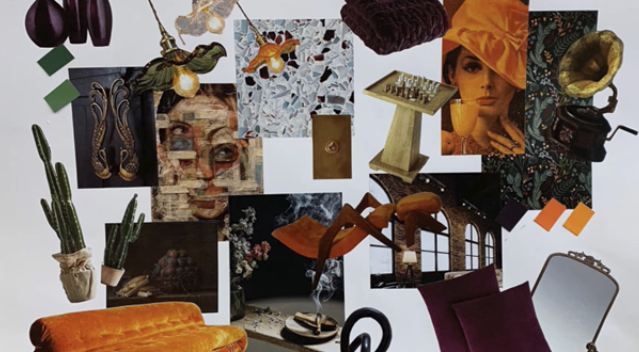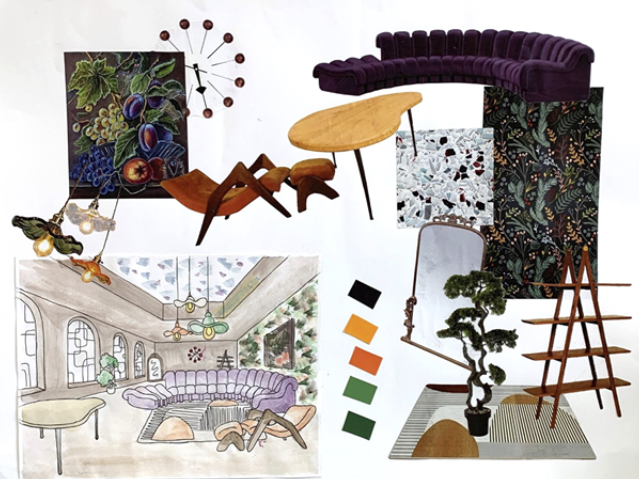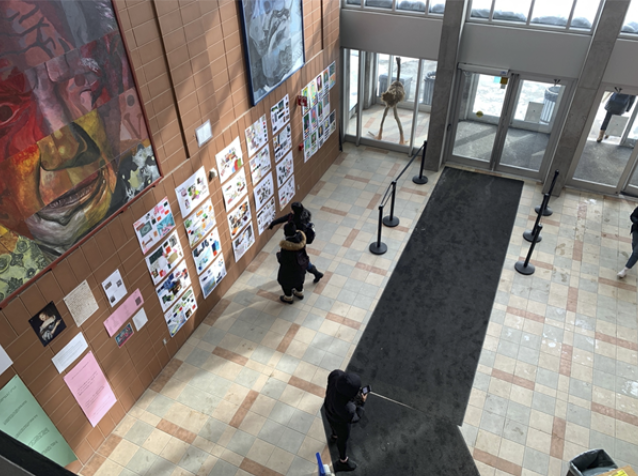Together, we linked the 1st French course in general education (a challenging course) and the Couleur 1 course in the Interior Design technical program:
- First, Caroline’s French students analyzed the letters of Madame de Sévigné.
- Next, Stephanie’s interior design students reinvested the information they had gathered about the writer’s inner world, creating rich settings for the woman who turned out to be their mystery client.
Who hasn’t dreamed of making an imagined universe tangible? Who hasn’t dreamed of extending themselves into someone else with talents they don’t have? Who doesn’t have unfulfilled passions in bank?
Our project was born of a shared desire to collaborate and constantly rethink our teaching. It was a return of sorts to the roots of CEGEPs: the idea of combining general and vocational education. This interdisciplinary project led us to explore new worlds both in literature and the visual arts (as a contributing discipline in interior design).
Presentation of our project in the form of an interview [in French]
A 1st word, a 1st touch of colour
In the winter of 2022, Caroline was chatting with 2 visual arts students and learned that one of their teachers, Stéphanie, was having them paint figures of speech. This piqued Caroline’s curiosity, and she contacted Stéphanie to find out more about this teacher who linked images to literature in her classes.
This meeting enabled us to break down the silos that can exist between different disciplines.
Madame de Sévigné in all her colourful splendour
In Caroline’s class, Madame de Sévigné’s correspondence was used to explore the constituent elements of a literary text. Working as a team, students produced a creative literary analysis of the texts.
Caroline’s students’ analysis was then reinvested by Stéphanie’s students. They worked on colour harmony and chromatic effects, creating a décor for Madame de Sévigné.
A large-scale experiment
A large pool of students took part in this 1st iteration of the project:
In Écriture et littérature [Writing and Literature], Caroline’s 3 groups (105 students) as well as 1 group of her colleague Émilie Cantin (30 students) analyzed Madame de Sévigné’s correspondence.
In Couleur 1, Stéphanie’s 4 groups (85 students) as well as 2 groups of her colleague Andréanne Godin (40 students) imagined the colours of Madame de Sévigné’s interior.
From words to colours
Our La couleur des mots project took place in 2 stages:
- First, the “Pantone file” was assigned in week 4 in the Écriture et littérature course. Students had to translate Madame de Sévigné’s inner world in teams of 4 or 5 (for 15% of their final course grade).
- Then, the “client file” was assigned in week 11 in the Couleur 1 course, where each student had to individually create an ambiance through colour (for 35% of their final course grade).
The Pantone file
In Caroline’s class, students had to transpose the key points of a literary text into other forms of language. They had to plunge into a literary text to go beyond its surface and reach its backbone.
All in all, the assignment was quite short and came early in the session. It challenged students to demonstrate creativity and intellectual curiosity, elements sometimes neglected in general education. Engagement, versatility, listening, and fun were also important characteristics. In fact, this project was an empowerment opportunity for the students. The innovative, more creative elements were added to the learning activities aimed directly at achieving the competency, which was fully respected.
The primer
The inspiration for the Pantone file assignment came from multidisciplinary artist Sophie Calle’s work Take Care of Yourself (2007), in which the artist asked 107 women from different backgrounds and professions to interpret in their own way, using whatever medium they wished, the breakup e-mail Sophie Calle had received. The result was an installation featuring text, photo, video, song, dance, and more. The break-up was revisited in 107 different ways.
Introducing Sophie Calle’s work in week 1 is evocative. Suddenly, the literary text is no longer the only option available to students for translating a person’s feelings and emotions. The possibilities are endless and vary according to the interests of each individual. Caroline found that, paradoxically, the more she agreed to break down the walls of her discipline, the more meaning it acquired in the eyes of her students.
Using Sophie Calle as an example, Caroline introduced the work of Madame de Sévigné, without naming the author. Biographical and sociohistorical elements were not given centre stage, in favour of what the epistolary correspondence between mother and daughter had to reveal in terms of both meaning and the formulations used.
Starting the session with letters from 17th century France is a challenge in itself. The turns of phrase are complex and convoluted, which is a challenge for many students. However, since the letters are not too long, and the students work in teams to dissect the text, it all works out quite well.
The creative part of the Pantone file
The 1st part of the assignment was creative, involving writing a 1-page text focused on emotions. For this part of the assignment, Caroline proposed different scenarios to the students:
- Exploring the text and making it their own, according to their program of study.
For example, one student translated Madame de Sévigné’s inner world on electric guitar. - Transforming Madame de Sévigné’s letter into a non-literary text.
- One team created a 5-course menu that reflects the different nuances of the text, explaining the choices and the links between the dishes and the text.
- Rewriting Madame de Sévigné’s letter, changing its form to:
- an exchange of text messages
- a song
- X’s (formerly tweets)
- etc.
These different scenarios for the creative text encourage all students to explain their choices. Since explanation is a key component of literary analysis, this exercise is highly relevant.

A team created the X (formerly Twitter) account “Celle qui se permet des lanterneries”. [She who allows herself to be frivolous].
The descriptive part of the Pantone file
The assignment also included a more descriptive part. In about 1 page, the students had to bring out the emotions in the text by associating them with different stimuli linked to the 5 senses. For example, one student associated Madame de Sévigné’s pain with sandpaper, which has a rougher side and a softer side.
Students also had to give their work a poetic title inspired by those given to different paint colours (“sparkling praline,” “comforting dawn,” etc.). We created our own colour chart!
Visit to the materials library and written presentation of selected materials
As the icing on the cake, Caroline and her students took a trip to the college’s materials library. (The simple act of walking to the materials library during a literature class feels like going on a mini “field trip” and makes the activity fun for the students). Students had to choose the most appropriate materials (tiles, wallpaper, etc.) to represent the spirit of the letter analyzed, and explain their choices, of course!
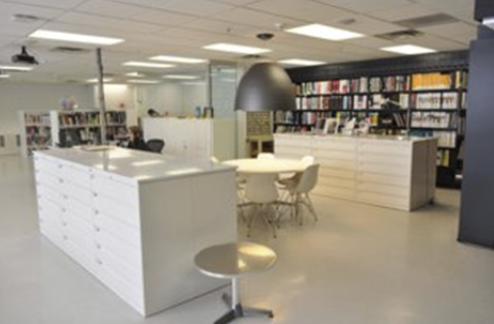
The college’s materials library
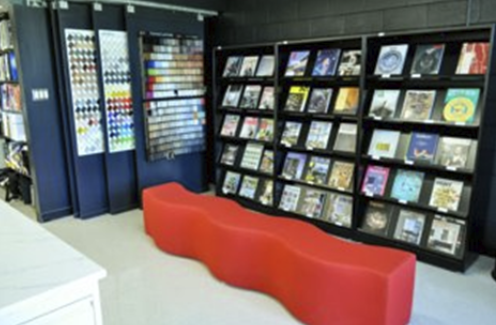
Another view of the college’s materials library
The visit to the materials library was an opportunity for many to reach a deeper level of understanding: just because there’s talk of a fire in the letter doesn’t mean you have to choose an orange motif; you have to go further, think harder.
Finally, the students also had to choose a piece of furniture that represented the author.
Shine in speaking also
Once the written assignments had been submitted, Caroline’s students led a class debate to determine the best materials and furniture to represent Madame de Sévigné. The final choices were shared with the interior design students. There was even an impromptu drawing competition on the blackboard, so that students could more confidently sell their choices and ideas. The students were really engaged in the project!

